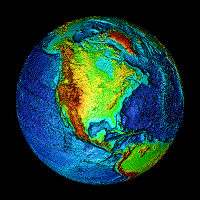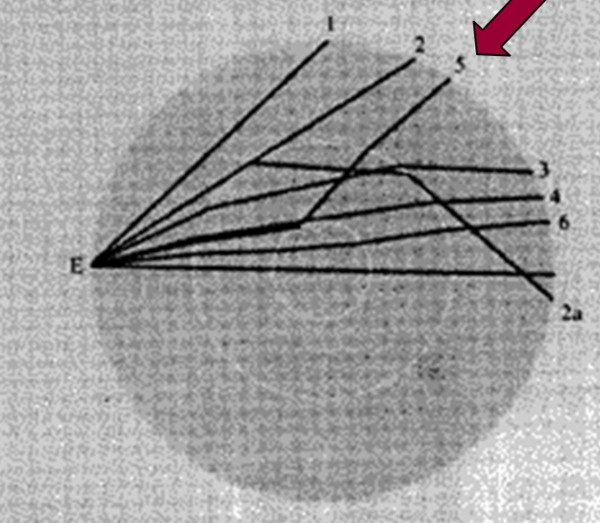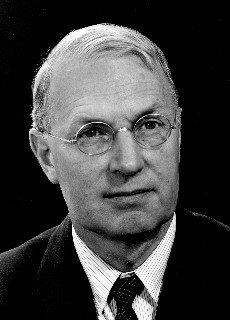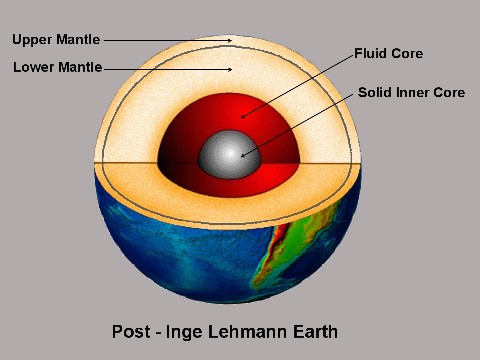 
Inge Lehmann's Discovery of the Earth's Inner Core |
|
  By the mid-1930s, size of the Earth's core was reasonably well established, as was the fact that it is a fluid. But then, earthquake waves were discovered in the so-called "shadow zone". When earthquake waves pass from one medium into another at an angle, the waves change speed and direction (like light passing from air into water). Consequently, there is a region at the Earth's surface called the shadow zone where earthquake waves should not have been able to be detected, but they were in fact detected and the reason was a great mystery. In 1936, the Danish seismologist, Inge Lehmann, pictured at left, solved that mystery. The figure at right, from Lehmann's original 1936 publication, shows her solution to that mystery. The red arrow was not part of her original diagram. The lines in that figure show possible paths of earthquake waves. Note the shadow zone between her numbers 2 and 3. Lehmann solved the great mystery by imagining the existence of a solid sphere, now called the inner core, which would reflect earthquake waves into the shadow zone, as shown by the ray highlighted with the red arrow. But then, the solution of one mystery created another: What is the composition of the Earth's inner core? Studies of earthquake waves can provide information on the physical state of deep-Earth matter, but not its chemical composition. For that, one must look to meteorites. There are three groups of meteorites, called chondrites, which which have bulk elemental compositions similar to the outer part of the Sun, at least for the non-gaseous elements. The Earth is thought to be similar in bulk elemental composition. |
|
There is no independent evidence that the Earth's inner core is composed of solidified nickel-iron metal. There is no independent evidence that the Earth's core is in the process of freezing. And, there is no independent evidence that the Earth is like an ordinary chondrite meteorite. Nearly, four decades passed before J. Marvin Herndon, in 1979, published a different idea about the composition of the Earth's inner core which he justified just a year later [3, 4]. |
|
When earthquake waves pass from one region into another and change speed and direction, it is because the earthquake waves either enter a region of different chemical composition or of different crystal structure. Consistent with the Birchian view, many have since assumed that the seismic boundary separating the Earth's mantle into two parts is caused by a change of crystal structure in a mantle of uniform composition. In 1980, J. Marvin Herndon discovered evidence to the contrary [4].
|
| References | |
| 1. |
Lehmann, I., P'. Publ. Int. Geod. Geophys. Union, Assoc. Seismol., Ser. A, Trav. Sci., 1936, 14, 87-115. |
| 2. | Birch, F., The transformation of iron at high pressures, and the problem of the Earth's magnetism. American Journal of Science, 1940, 238, 192-211. |
| 3. | Herndon, J. M., The nickel silicide inner core of the Earth. Proceedings of the Royal Society of London, 1979, A368, 495-500. (click here for pdf) |
| 4. | Herndon, J. M., The chemical composition of the interior shells of the Earth. Proceedings of the Royal Society of London, 1980, A372, 149-154. (click here for pdf) |
 In
1940, Harvard Professor Francis Birch, pictured at right, thought he had solved
that mystery. Birch believed the Earth was like an ordinary chondrite
meteorite, one of the most common meteorites observed to fall to Earth from
space.
He knew that in the metal of those meteorites, nickel and iron invariably
occurred alloyed together. He also knew that elements heavier than nickel and
iron were insufficiently abundant to form a body with the mass of the inner
core. Birch therefore assumed that the fluid core was in the process of
freezing, with the inner core having already frozen solid and having a
composition more or less like the fluid core [2]. At the time all seemed
reasonable. But, there were problems that would not be recognized for nearly
forty years.
In
1940, Harvard Professor Francis Birch, pictured at right, thought he had solved
that mystery. Birch believed the Earth was like an ordinary chondrite
meteorite, one of the most common meteorites observed to fall to Earth from
space.
He knew that in the metal of those meteorites, nickel and iron invariably
occurred alloyed together. He also knew that elements heavier than nickel and
iron were insufficiently abundant to form a body with the mass of the inner
core. Birch therefore assumed that the fluid core was in the process of
freezing, with the inner core having already frozen solid and having a
composition more or less like the fluid core [2]. At the time all seemed
reasonable. But, there were problems that would not be recognized for nearly
forty years. The figure at left shows the main parts of the
Earth. Note the boundary between the Lower Mantle and the Upper Mantle. Francis
Birch thought that the mantle is of uniform elemental composition.
The figure at left shows the main parts of the
Earth. Note the boundary between the Lower Mantle and the Upper Mantle. Francis
Birch thought that the mantle is of uniform elemental composition.